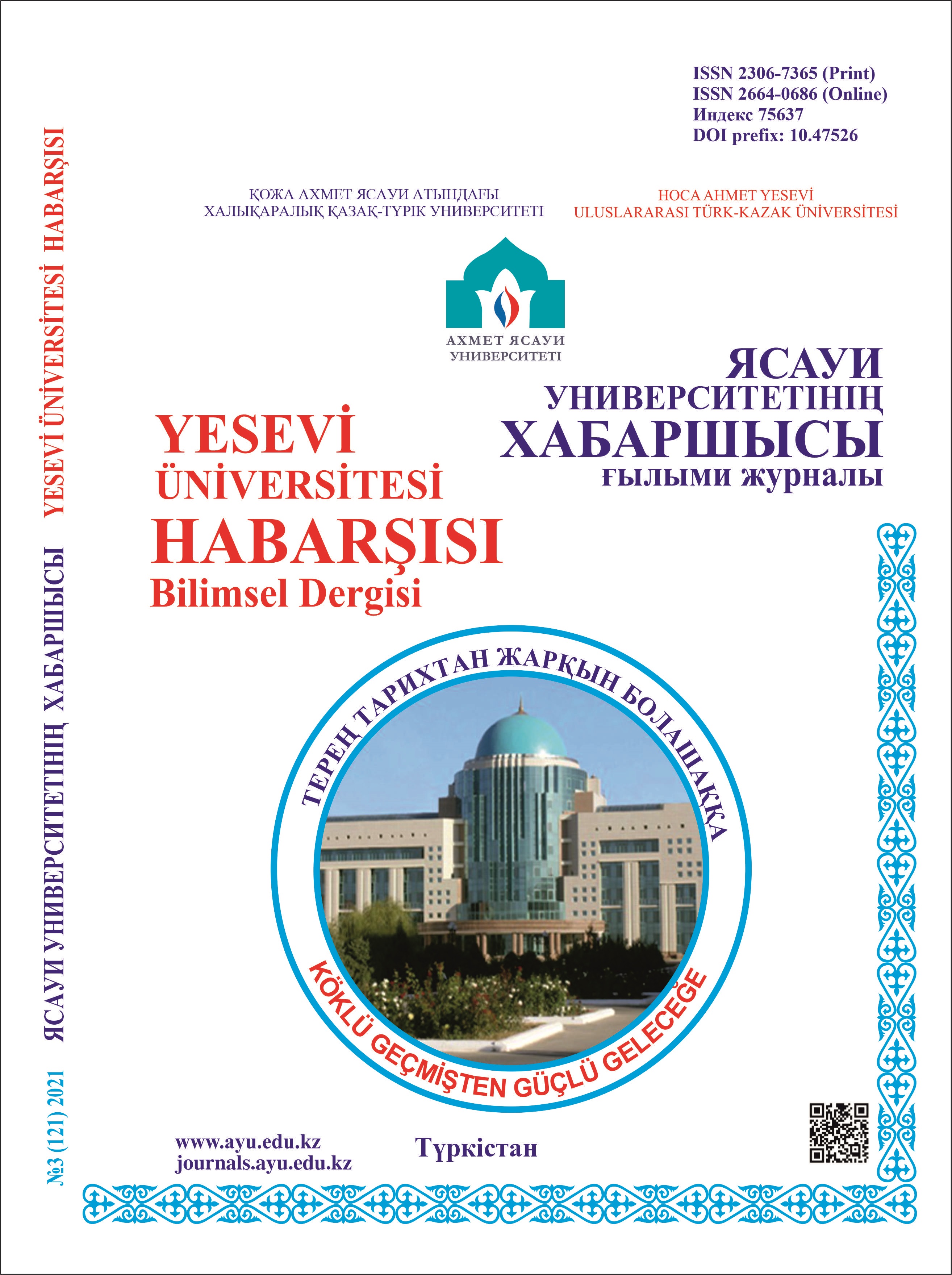The Manifestation of Prose in the Independence Period: The Artistic Features of B. Sarybai’s Works
64 99
Keywords:
psychologism, philosophy, artistic dialogue, time and space, modernist trend, symbolism.Abstract
This article explores the development trends of Kazakh prose during the period of independence, based on Beibit Sarybay’s short stories “Rauǵash erte güldeıdi” (“Rhubarb Blooms Early”), “Meıirim” (“Compassion”), and “Öliara” (“Interseason”). The spiritual values depicted in the author’s works, the deep psychological layers of human nature, and the relationship between society and the individual are examined from an artistic perspective. Through his narratives, the writer skillfully conveys the social, moral, and philosophical issues of Kazakh society in the independence era, while expressing the national worldview and the spirit of the times through artistic imagery.
The central character analyzed in this article is Rauǵash – a delicate, introspective, and life-loving individual in constant spiritual search – who frequently appears in Sarybay's creative universe. The inner struggle of Rauǵash is portrayed as a dual conflict: the effort to preserve hope in one’s life and the resistance against external pressures. In “Meıirim”, the character Ūlan embodies an existential image. Through Ūlan, the writer addresses vanishing spiritual purity and core human values such as compassion and forgiveness in today’s society. The author seeks not only to depict the outward behaviors of people but also to delve into their inner world, sorrows, longing, and lost warmth. This reveals the protagonist's spiritual purity and the author's artistic integrity.
In addition, the environment surrounding Almat in the story “Öliara” – his parents’ expectations, the pressure from teachers, and society’s insistence on success – presents the Unified National Testing (UNT) not merely as an academic challenge but as the sole path to life and the future. This becomes a socio-cultural detail. The writer thus implies that children today are viewed not as individuals, but as tools for achieving results. The article analyzes the system of characters, inner monologue, psychological depth (psychologism), metaphor, and symbolism, incorporating elements of literary theory.
References
ПАЙДАЛАНЫЛҒАН ӘДЕБИЕТТЕР ТІЗІМІ
Мәдібай Қ.Қ. Көркемдік кеңістігі. – Алматы: Қазақ университеті, 2014. – 215 б.
Сарыбай Б. Рауғаш ерте гүлдейді. – Алматы: Жалын, 2009. – 160 б.
Глушко А. Требование времени и возможности жанра: проблемы рассказа // В кн.: Методологические проблемы советской литературной критики. – М.: Мысль, 1976. – С. 206-217.
Рақымжанов Т. Қазақ прозасындағы психологизм. – Алматы: Абай атындағы ҚазҰПУ, 2016. – 160 б.
Ковалев Вл.А. О стиле художественной прозы Л.Н. Толстого. – М.: Изд. Моск. Ун-та., 1960. – 63 с.
Пірәлиева Г. Ішкі монолог. – Алматы: «Ер–Дәулет–Қазақстан» 1994. – 200 б.
Портнова Н.А. К проблеме парадоксальности стиля Достоевского. // В кн.: Достоевский. Материалы и исследования. Т.7. – Ленинград: «Наука», 1987. – 293 с. 8. Тоқсамбаева А.О. Мұхтар Мағауин шығармаларының көркемдік-эстетикалық танымы // «Қазақ әдебиеті». Жинақ. – 2005. – №4. – Б. 36–42.
Таборисская Е., Штейнгольд А. Творческая индивидуальность писателя // В кн.: Пути анализа литературного произведения. – М.: Просвещение, 1981. – С. 50–71.
Тұңғышбаева Ғ.Ж., Қожахметова Ф.Б. Эпикалық жанрлар табиғаты // ҚазҰУ хабаршысы. Филология сериясы. – 2017. – №2 (166). – Б. 124–129.
REFERENCES
Madіbai Q.Q. Korkemdіk kenіstіgі [The Artistic Space]. – Almaty: Qazaq universitetі, 2014. – 215 b. [in Kazakh] 2. Sarybai B. Raugash erte guldeidі [Rhubarb Blooms Early]. – Almaty: Zhalyn, 2009. – 160 b. [in Kazakh] 3. Glushko A. Trebovanie vremeni i vozmozhnosti zhanra: problemy rasskaza // V kn.: Metodologicheskie problemy sovetskoi literaturnoi kritiki [The Demand of the Time and the Possibilities of the Genre: Problems of the Short Story // In: Methodological Problems of Soviet Literary Criticism]. – M.: Mysl, 1976. – S. 206–217. [in Russian] 4. Raqymzhanov T. Qazaq prozasyndagy psihologizm [Psychologism in Kazakh Prose]. – Almaty: Abai atyndagy QazUPU, 2016. – 160 b. [in Kazakh] 5. Kovalev Vl.A. O stile hudozhestvennoi prozy L.N. Tolstogo [On the Style of Leo Tolstoy’s Artistic Prose]. – M.: Izd. Mosk. Un-ta., 1960. – 63 s. [in Russian] 6. Pіralieva G. Іshkі monolog [The Inner Monologue]. – Almaty: «Er–Daulet–Qazaqstan» 1994. – 200 b. [in Kazakh] 7. Portnova N.A. K probleme paradoksalnosti stilia Dostoevskogo. // V kn.: Dostoevskiy. Materialy i issledovania. T.7. [On the Problem of the Paradoxical Style of Dostoevsky // In: Dostoevsky: Materials and Research. Vol. 7.]. – Leningrad: «Nauka», 1987. – 293 s. [in Russian] 8. Toqsambaeva A.O. Muhtar Magauin shygarmalarynyn korkemdіk-estetikalyq tanymy [The Artistic-Aesthetic Perception in the Works of Mukhtar Magauin] // «Qazaq adebietі». Zhinaq. – 2005. – №4. – B. 36–42. [in Kazakh] 9. Taborisskaia E., Shteingold A. Tvorcheskaia individualnost pisatelia // V kn.: Puti analiza literaturnogo proizvedenia [The Creative Individuality of the Writer // In: Ways of Analyzing a Literary Work]. – M.: Prosveshenie, 1981. – S. 50–71. [in Russian] 10. Tungyshbaeva G.Zh., Qozhahmetova F.B. Epikalyq zhanrlar tabigaty [The Nature of Epic Genres] // QazUU habarshysy. Filologia seriasy. – 2017. – №2 (166). – B. 124–129. [in Kazakh]

